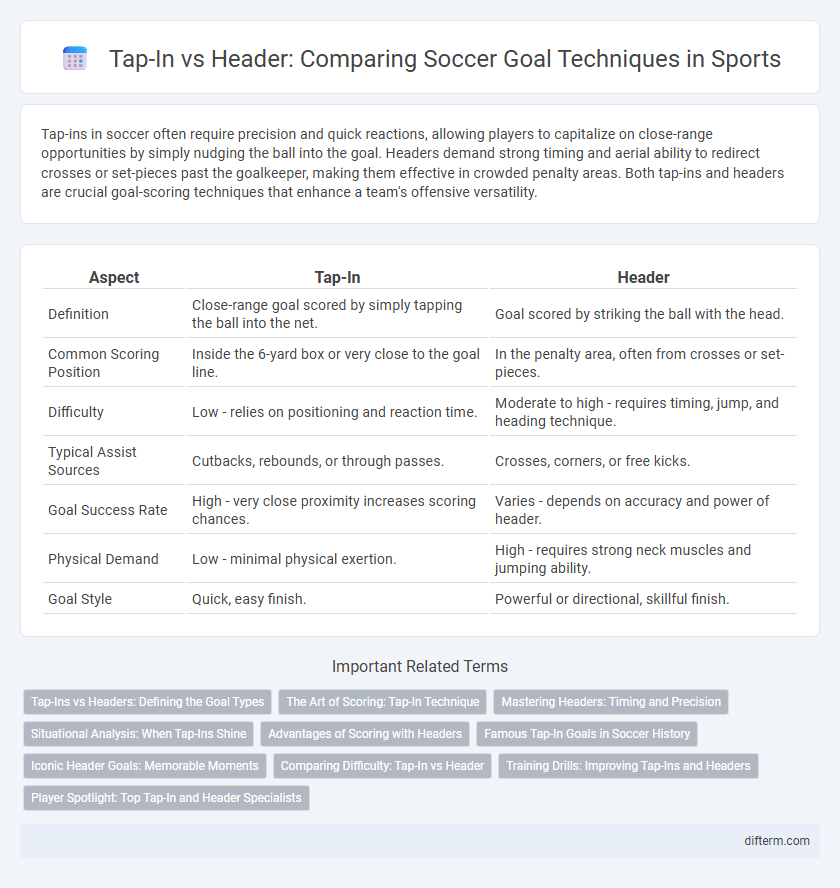Tap-ins in soccer often require precision and quick reactions, allowing players to capitalize on close-range opportunities by simply nudging the ball into the goal. Headers demand strong timing and aerial ability to redirect crosses or set-pieces past the goalkeeper, making them effective in crowded penalty areas. Both tap-ins and headers are crucial goal-scoring techniques that enhance a team's offensive versatility.
Table of Comparison
| Aspect | Tap-In | Header |
|---|---|---|
| Definition | Close-range goal scored by simply tapping the ball into the net. | Goal scored by striking the ball with the head. |
| Common Scoring Position | Inside the 6-yard box or very close to the goal line. | In the penalty area, often from crosses or set-pieces. |
| Difficulty | Low - relies on positioning and reaction time. | Moderate to high - requires timing, jump, and heading technique. |
| Typical Assist Sources | Cutbacks, rebounds, or through passes. | Crosses, corners, or free kicks. |
| Goal Success Rate | High - very close proximity increases scoring chances. | Varies - depends on accuracy and power of header. |
| Physical Demand | Low - minimal physical exertion. | High - requires strong neck muscles and jumping ability. |
| Goal Style | Quick, easy finish. | Powerful or directional, skillful finish. |
Tap-Ins vs Headers: Defining the Goal Types
Tap-in goals in soccer are characterized by close-range finishes with minimal effort, typically following precise passes or rebounds, emphasizing positioning and timing. Headers, on the other hand, rely on aerial ability and timing, involving directing the ball into the net using the head, often during crosses or set-pieces. The key distinction lies in the technique and ball trajectory, with tap-ins usually resulting from ground-level plays and headers from airborne opportunities.
The Art of Scoring: Tap-In Technique
The tap-in technique in soccer involves scoring goals with minimal effort by placing the ball into an open net after a teammate's precise pass or a saved shot. This method emphasizes positioning, timing, and anticipation rather than power, often resulting in high-percentage scoring opportunities inside the penalty area. Tap-in goals are crucial in professional matches, demonstrating a player's ability to read the game and capitalize on chances created by team play.
Mastering Headers: Timing and Precision
Mastering headers in soccer requires impeccable timing and precision to outmaneuver defenders and goalkeepers. Unlike tap-in goals, which rely on close-range positioning and quick reactions, headers demand aerial accuracy and the ability to judge the ball's trajectory in mid-air. Successful headers often turn tight crosses into scoring opportunities, showcasing a player's spatial awareness and physical control.
Situational Analysis: When Tap-Ins Shine
Tap-in goals excel in scenarios with high-pressure offensive plays inside the six-yard box, where precision and quick reactions maximize scoring chances in crowded goalmouths. Headers become more effective during aerial duels in set-piece situations like corners and crosses, leveraging a player's timing and positioning to convert chances. In tight spaces near the goal line, tap-ins provide a more reliable option due to minimal ball control and rapid finishing requirements.
Advantages of Scoring with Headers
Scoring with headers in soccer offers distinct advantages, particularly in aerial duels where precision and timing can outperform power shots. Headers allow players to capitalize on crosses and set-pieces, increasing scoring opportunities within the crowded penalty box. The ability to direct the ball accurately with the head often makes it more difficult for goalkeepers to predict and save these goals compared to tap-in shots.
Famous Tap-In Goals in Soccer History
Famous tap-in goals in soccer history showcase the precision and positioning of elite strikers, often requiring minimal effort yet demonstrating exceptional anticipation. Iconic examples include Didier Drogba's decisive tap-in for Chelsea in the 2012 UEFA Champions League final and Andy Cole's clinical finish during Manchester United's treble-winning season in 1998-99. These moments epitomize the effectiveness of tap-ins compared to headers, emphasizing timing and proximity over aerial prowess.
Iconic Header Goals: Memorable Moments
Iconic header goals in soccer showcase incredible timing, positioning, and aerial skill, often changing the outcome of crucial matches. Legendary moments, such as Diego Maradona's winning header against England in 1986, highlight the dramatic impact of well-executed headers. These goals emphasize precision and power, standing out compared to simpler tap-in finishes that rely on proximity and positioning.
Comparing Difficulty: Tap-In vs Header
Scoring a tap-in goal in soccer is generally considered easier due to the close proximity to the goal and minimal required skill, relying mostly on positioning and timing. In contrast, a header demands precise aerial technique, strong neck muscles, and the ability to judge the ball's trajectory under pressure, making it more challenging. Statistical analyses show that headers have a lower conversion rate compared to tap-ins, highlighting the higher difficulty associated with aerial scoring.
Training Drills: Improving Tap-Ins and Headers
Training drills that enhance tap-in proficiency focus on close-range finishing techniques, emphasizing quick reactions and precise ball control to capitalize on scoring opportunities. Header improvement drills concentrate on timing, positioning, and neck muscle strength, enabling players to generate power and accuracy during aerial challenges. Incorporating targeted exercises like crossing and volley drills builds coordination, essential for mastering both tap-ins and headers in competitive soccer matches.
Player Spotlight: Top Tap-In and Header Specialists
Top tap-in specialists like Lionel Messi showcase exceptional positioning and composure inside the box, converting high-percentage chances with precision. Header experts such as Cristiano Ronaldo dominate aerial duels, leveraging timing and height to score crucial goals from crosses and set pieces. Both skill sets demonstrate specialized finishing techniques that significantly contribute to a team's goal tally in soccer.
tap-in vs header (soccer goals) Infographic

 difterm.com
difterm.com